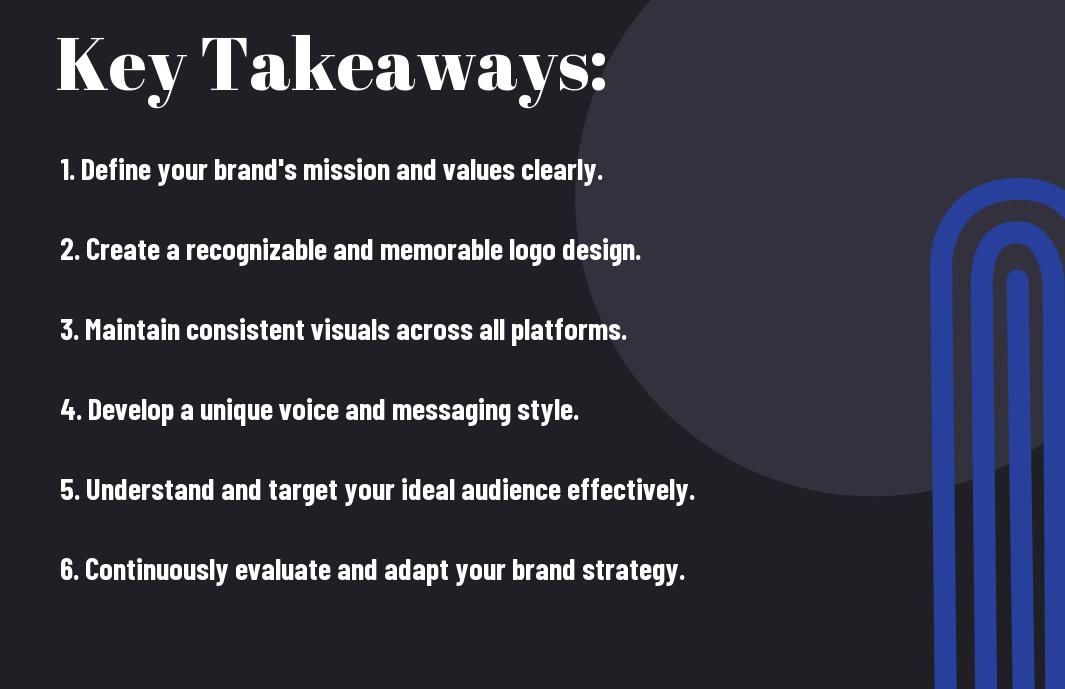
Just as a house needs a solid foundation, your brand requires a strong identity to stand out in today’s competitive market. By understanding the key elements that define your brand, you can create a cohesive image that resonates with your target audience. From your logo and color palette to your messaging and values, every aspect plays a vital role in shaping how customers perceive your business. In this post, you will uncover vital strategies to develop a brand identity that not only reflects who you are but also builds lasting connections with your audience.

Understanding Brand Identity
To establish a memorable presence in the market, you need to grasp the concept of brand identity. This encompasses the visual elements, messaging, and values that collectively form how your audience perceives your brand. By understanding the intricacies of brand identity, you can effectively communicate your essence and differentiate yourself from competitors.
Definition of Brand Identity
An effective brand identity combines various components, including logos, colors, typography, and messaging, to create a distinct persona for your business. It’s the representation of what your brand stands for and how you want your customers to recognize and relate to you.
Importance of Brand Identity
Brand identity shapes how consumers perceive your business and influences their decisions. It builds trust, fosters loyalty, and establishes an emotional connection with your target audience.
With a strong brand identity, you not only attract new customers but also keep existing ones coming back. It helps you set expectations and convey your unique value proposition effectively. By developing a clear and compelling brand identity, you position yourself as a leader in your industry, making your brand more memorable and fostering long-lasting relationships with your audience.
Elements of a Strong Brand Identity
One of the foundational aspects of building a solid brand identity lies in understanding its core elements. These include your logo, color palette, typography, and visual style, all of which come together to create a cohesive representation of your brand. By carefully crafting each element, you can ensure that your brand communicates its values, resonates with your target audience, and stands out in a crowded market.
Logo and Visual Elements
Any effective brand identity begins with a well-designed logo and compelling visual elements. Your logo serves as the face of your brand, encapsulating your message and values in a single image. Paired with strong visual elements, your logo will help establish recognition and foster emotional connections with your audience.
Typography and Color Palette
Across all your branding materials, typography and your color palette work together to convey your brand’s personality and message. The fonts you choose can evoke different feelings, while your color selection speaks volumes about your brand identity. Together, these elements create a consistent look and feel that is easily recognizable.
Palette choices set the emotional tone for your brand. Colors can influence perceptions; for example, blue often conveys trust, while red evokes energy and passion. Typography also plays a significant role in readability and conveying your brand’s character. A playful font can add a casual vibe, while a serif typeface may give a more authoritative feel. By strategically aligning your typography and color palette, you create a unified brand identity that enhances recognition and builds trust among your audience.
Crafting Your Brand Message
All successful brands understand the importance of a compelling brand message. This message encapsulates your mission, vision, and values, and serves as the foundation of your communication strategies. By clearly articulating what you stand for, you connect with your audience on a deeper level, fostering loyalty and trust. A well-crafted brand message will differentiate you from competitors and resonate with your target demographic, ensuring that your brand remains memorable and relevant in the marketplace.
Defining Your Brand Voice
With a defined brand voice, you ensure consistency in your messaging across all platforms. This voice reflects your brand’s personality and influences how your audience perceives you. Think about the tone and language that align with your values and mission, whether it’s formal, friendly, authoritative, or playful. By clearly identifying and consistently utilizing your brand voice, you create a cohesive experience that strengthens your connection with your audience.
Creating a Unique Value Proposition
Proposition your unique value proposition (UVP) is what sets you apart from your competitors and clarifies why customers should choose you. It distills what you offer into a clear, concise statement that highlights the specific benefits your brand provides. To formulate this, contemplate the problems your target audience faces and how your products or services uniquely solve these issues. A strong UVP effectively communicates your advantage, making it easier for potential customers to understand the value you bring.
Also, your UVP must resonate emotionally with your audience, appealing to their desires and pain points. Conduct market research to gather insights and refine your message so it effectively aligns with your customers’ expectations. When presenting your UVP, be clear and direct, emphasizing key differentiators that showcase what makes your brand special. By investing time in crafting a compelling unique value proposition, you lay the groundwork for a strong brand identity that attracts and retains customers.
Aligning Brand Identity with Target Audience
Your brand identity should resonate with your target audience to create meaningful connections and foster loyalty. By understanding and aligning your brand elements with the values, desires, and preferences of your audience, you enhance your brand’s relevance and appeal. This strategic alignment not only cultivates a consistent image but also drives customer engagement and satisfaction.
Identifying Your Audience
The first step in aligning your brand identity is identifying your audience. Take the time to understand their demographics, interests, and behaviors. This knowledge allows you to create a profile of your ideal customer, enabling you to tailor your brand message and offerings effectively to meet their needs.
Tailoring Your Message
The next vital step is tailoring your message to resonate with your identified audience. Speak directly to their values and aspirations by utilizing the language, tone, and visuals that appeal to them. By doing so, you foster a deeper connection that reinforces your brand identity while adequately addressing the pain points and desires of your customers.
In addition, focus on personalizing your communications and branding efforts. Showcasing relatable storytelling, using targeted marketing strategies, and incorporating feedback can further strengthen this connection. When your message aligns seamlessly with your audience’s expectations and experiences, your brand becomes more than just a product or service; it transforms into a shared journey with your customers. This makes them more likely to engage with your brand and become loyal advocates.
Consistency Across Platforms
Unlike a haphazard approach, maintaining consistency across all platforms helps to create a cohesive brand identity. Whether you’re engaging on social media, your website, or through email marketing, aligning your messaging and visual elements ensures that your audience recognizes your brand, fostering trust and loyalty. In a crowded digital landscape, consistency will set you apart and enable you to reinforce your brand values effectively.
Maintaining Visual Consistency
An effective brand identity incorporates visual elements such as color schemes, logos, and typography consistently across all touchpoints. This consistency aids recognition and enhances the overall perception of your brand by creating a polished and professional appearance. When your visuals align seamlessly, they communicate your brand’s essence and create familiarity that resonates with your audience.
Ensuring Message Uniformity
About your brand messaging, it is vital to ensure that the tone and content remain consistent regardless of the platform. Each interaction with your audience should reflect your core values, mission, and personality, helping to reinforce your brand’s identity.
In addition to visual elements, your messaging needs to echo your brand’s primary themes across all platforms. This includes using similar language, tone, and terminology that reflect your brand’s personality. Whether you are crafting a social media post, writing a blog, or designing an advertisement, consistency in messaging solidifies how your audience perceives your brand. By doing so, you create a unified voice that resonates with your target market, fostering stronger connections and building brand loyalty over time.
Monitoring and Evolving Your Brand Identity
For a brand to thrive, it’s vital to continuously monitor and evolve your brand identity. This involves staying attuned to consumer perceptions, industry trends, and competitive landscapes. You should regularly assess how your brand is aligned with its mission and values, while also being ready to pivot when necessary. Embracing change can enhance your brand’s relevance and ensure lasting success in a dynamic market.
Gathering Feedback
To build a robust brand, actively seek and gather feedback from your audience. Utilize surveys, social media interactions, and direct conversations to understand how your brand is perceived. This valuable input can guide your decisions and help you make informed adjustments to your brand identity.
Adapting to Market Changes
Above all, staying flexible and responsive to market changes is vital for brand longevity. Your industry is constantly evolving, influenced by new technologies, shifting consumer preferences, and emerging competitors. To remain relevant, you need to continuously evaluate these factors and be willing to revise your branding strategies accordingly.
Considering the fast-paced nature of today’s marketplace, it’s vital to keep an eye on trends and innovations that could impact your brand. You may find that changing demographic preferences or advancements in technologies require you to adapt your messaging or visual elements. Regularly revisiting your brand’s goals and aligning them with current consumer expectations can help you maintain a strong identity and foster loyalty among your audience.
Final Words
Following this guide, you can successfully craft a strong brand identity that resonates with your audience and sets you apart in the marketplace. By understanding your target market, developing a clear message, and utilizing consistent visuals, you can create a powerful presence that fosters trust and loyalty. Pay attention to feedback and adapt as necessary, ensuring your brand evolves without losing its core values. With dedication and a strategic approach, your brand identity will not only represent your business but also connect deeply with those you serve.
Leave a Reply